- Clone
- 7A6 (See other available formats)
- Regulatory Status
- RUO
- Other Names
- Nuclear factor of activated T-cells, cytoplasmic 1, NFAT transcription complex cytosolic component, NFAT2, NFATc
- Isotype
- Mouse IgG1, κ
- Ave. Rating
- Submit a Review
- Product Citations
- publications
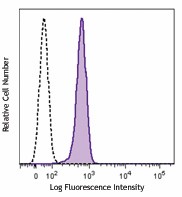
-

Human peripheral blood lymphocytes were treated with pre-chilled 1% PFA plus 70% ethanol, then intracellularly stained with NFATc1 (clone 7A6) Alexa Fluor® 488 (filled histogram) or mouse IgG1, κ Alexa Fluor® 488 isotype control (open histogram).
| Cat # | Size | Price | Quantity Check Availability | Save | ||
|---|---|---|---|---|---|---|
| 649603 | 25 µg | 118€ | ||||
| 649604 | 100 µg | 278€ | ||||
The product of this gene is a component of the nuclear factor of activated T cells DNA-binding transcription complex. The protein complex consists of NFAT1, NFAT2 (NFATc1 or NFATc), NFAT3, and NFAT4. All members of this family are transcription factors with a Rel homology domain and regulate gene transcription in concert with AP-1 (Jun/Fos) to orchestrate an effective immune response. NFAT proteins are predominantly expressed in cells of the immune system but are also expressed in skeletal muscle, keratinocytes and adipocytes, regulating cell differentiation programs in these cells. In resting cells, NFAT proteins are heavily phosphorylated and localized in the cytoplasm. Increased intracellular calcium concentrations activate the calcium/calmodulin-dependent serine phosphatase calcineurin, which dephosphorylates NFAT proteins, resulting in their subsequent translocation to the nucleus.
Proteins belonging to this family of transcription factors play a central role in inducible gene transcription during immune response. The product of this gene is an inducible nuclear component. It functions as a major molecular target for the immunosuppressive drugs such as cyclosporin A. Five transcript variants encoding distinct isoforms have been identified for this gene. Different isoforms of this protein may regulate inducible expression of different cytokine genes.
Product DetailsProduct Details
- Verified Reactivity
- Human, Mouse, Rat
- Antibody Type
- Monoclonal
- Host Species
- Mouse
- Immunogen
- Recombinant protein of human NFATc1 amino acids 197-304.
- Formulation
- Phosphate-buffered solution, pH 7.2, containing 0.09% sodium azide.
- Preparation
- The antibody was purified by affinity chromatography and conjugated with Alexa Fluor® 488 under optimal conditions.
- Concentration
- 0.5 mg/mL
- Storage & Handling
- The antibody solution should be stored undiluted between 2°C and 8°C, and protected from prolonged exposure to light. Do not freeze.
- Application
-
ICFC - Quality tested
- Recommended Usage
-
Each lot of this antibody is quality control tested by immunofluorescent staining with flow cytometric analysis. For flow cytometric staining, the suggested use of this reagent is ≤0.25 µg per million cells in 100 µL volume. It is recommended that the reagent be titrated for optimal performance for each application.
* Alexa Fluor® 488 has a maximum emission of 519 nm when it is excited at 488 nm.
Alexa Fluor® and Pacific Blue™ are trademarks of Life Technologies Corporation.
View full statement regarding label licenses - Excitation Laser
-
Blue Laser (488 nm)
- Application Notes
-
7A6 antibody detects endogenous human NFATC1 in Western blot with an approximate molecular weight of 100 - 120 kD (different isoforms) (Cat. No. 649602). The optimal concentration should be determined by titration for each individual assay of interest.
Clone 7A6 Intracellular Staining Procedure:
- Prepare the fix/perm solution, consisting of 1% paraformaldehyde in 70% ethanol. Chill for at least one hour at -20°C.
- Suspend cells in cell staining buffer and perform surface stain if necessary.
- Centrifuge for 5 minutes at 1500 RPM and discard supernatant.
- Resuspend cells in 500 µL of fix/perm solution for up to 2 x 10^6 cells and gently vortex.
- Incubate cells on ice for 30-60 minutes in the dark.
- Add 2 mL PBS and centrifuge cells for 1500 RPM for 5 minutes.
- Wash cells 1X with 2 mL cell staining buffer, centrifuge at 1500 RPM for 5 minutes, discard supernatant.
- Adjust cell concentration to about 1 x 10^7 cells/mL, add 100 µL (~ 1 x 10^6 cells) to a FACS tube that already contains the staining antibody and mix gently.
- Incubate 15 minutes at room temperature.
- Wash 2X with cell staining buffer as in step 6.
- Resuspend cells in cell staining buffer and analyze.
-
Application References
(PubMed link indicates BioLegend citation) -
- Timmerman LA, et al. 1997. J. Immunol. 159:2735. (IF)
- Brandt C, et al. 2010. Cytometry A. 77:607. (FC)
- Fan W, et al. 2012. Arthritis Rheum. 64:3715. PubMed
- Product Citations
-
- RRID
-
AB_2561822 (BioLegend Cat. No. 649603)
AB_2561823 (BioLegend Cat. No. 649604)
Antigen Details
- Structure
- 943 amino acids with predicted molecular weight of 101 kD.
- Distribution
-
Cytoplasm, Nucleus. NFATc1 is cytoplasmic in the phosphorylated form and nuclear after calcineurin-mediated dephosphorylation controlled activation.
- Biology Area
- Cell Biology, Immunology, Neuroscience, Neuroscience Cell Markers, Signal Transduction, Transcription Factors
- Molecular Family
- Nuclear Markers
- Antigen References
-
1. Zhao Q, et al. 2010. Int. J. Biochem. Cell Biol. 42:576.
2. Hoey T, et al. 1995. Immunity 2:461.
3. Northrop JP, et al. 1993. J. Biol. Chem. 268:2917.
4. Hogan PG, et al. 2003. Genes Dev. 17:2205.
5. Shaw KT, et al. 1995. P. Natl. Acad. Sci. USA 92:11205.
6. Serfling E, et al. 2007. Sci. STKE 138:pe42. - Gene ID
- 4772 View all products for this Gene ID
- UniProt
- View information about NFATc1 on UniProt.org
Related Pages & Pathways
Pages
Related FAQs
Other Formats
View All NFATc1 Reagents Request Custom Conjugation| Description | Clone | Applications |
|---|---|---|
| PE anti-NFATc1 | 7A6 | ICFC |
| Purified anti-NFATc1 | 7A6 | WB,FC,ICC,ChIP |
| Alexa Fluor® 488 anti-NFATc1 | 7A6 | ICFC |
Customers Also Purchased
Compare Data Across All Formats
This data display is provided for general comparisons between formats.
Your actual data may vary due to variations in samples, target cells, instruments and their settings, staining conditions, and other factors.
If you need assistance with selecting the best format contact our expert technical support team.
-
PE anti-NFATc1
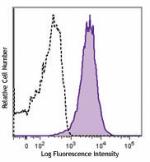
Human peripheral blood lymphocytes were fixed and permeabili... -
Purified anti-NFATc1
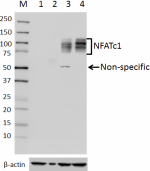
Total lysates (15 µg protein) from EL4 (lane 1), HeLa (lane ... 
Chromatin Immunoprecipitation (ChIP) was performed using Go-... 
Chromatin Immunoprecipitation (ChIP) was performed using Go-... -
Alexa Fluor® 488 anti-NFATc1
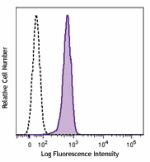
Human peripheral blood lymphocytes were treated with pre-chi...
 Login / Register
Login / Register 











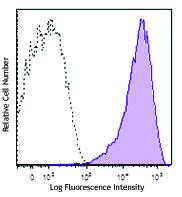
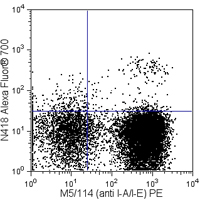



Follow Us